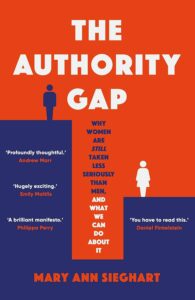 Reviewed by Canon Mike D Williams
Reviewed by Canon Mike D Williams
Back in 2021 Mary Ann Sieghart published this book which sets out the evidence about why women are still taken less seriously than men.
Women recognise the reality of the authority gap, but many men do not. The first chapter is for those who don’t believe the problem exists. The evidence is stark. Starting with the story of a writer Catherine Nichols who approached fifty literary agents with her first novel. She had two positive replies. Then she created a new email address in a man’s name and approached another fifty agents. This time she got seventeen positive responses. Researchers have shown similar results when they have created identical applications for a job and then used male and female names. Male applicants are often favoured illustrating an unconscious bias on the part of the decision makers.
There are fifteen chapters. Each begins with a cartoon and quote that gives an insight into the content. The first four chapters set out what the authority gap is and how we might all benefit from narrowing the gap. From Chapter five Mary Ann begins to delve into the underlying causes and what can be done about it.
Men are often more confident but there is a difference between confidence and competence. Woman leaders suffer from imposter syndrome more than twice as much as men, according to research. From a young age children appear to assign greater intelligence to males. Mary Ann notes that girls are taught by parents, teachers, and their own peers to be more modest and self-depreciating than boys. Mary Ann draws on her own experiences as a senior journalist in a male dominated environment. She decided to act confidently and stand up to her boss. Yet a confident woman can be seen by men as ‘too pushy’, as illustrated by stories told in the book.
‘Books of the Year’ recommendations in various publications show a considerable bias towards male reviewers; they in turn were four times more likely to recommend books by men. Perhaps it is not surprising that Phyllis Dorothy James choose to publish her crime novels as P.D. James. In every chapter the evidence is clear – there is an underlying and often unchallenged assumption that men have more authority than women.
The final chapter sets out what can be done to close the gap. The chapter begins with a quote “The greatest barrier to gender equality is the fact that we have a male dominated world, and many men don’t even realise this…” Might I suggest that this is a book for men to read.